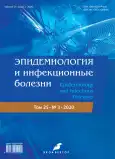Incidence of brucellosis in the Republic of Dagestan in 2019
- Authors: Shakhmardanov M.Z.1, Abusueva A.S.2, Nikiforov V.V.1, Tomilin Y.N.1, Burova S.V.1
-
Affiliations:
- Pirogov Russian National Research Medical University
- Dagestan state medical University
- Issue: Vol 25, No 3 (2020)
- Pages: 112-116
- Section: Original study articles
- URL: https://journals.rcsi.science/1560-9529/article/view/50362
- DOI: https://doi.org/10.17816/EID50362
- ID: 50362
Cite item
Full Text
Abstract
BACKGROUND: Currently, brucellosis continues to pose a serious problem for public health and agriculture in Russia. In 2019, the number of Russian cases of bovine brucellosis increased by 14%, and the number of first-time identified poor points for small cattle brucellosis increased by 52%. Epizootics of the disease are registered mainly in North Caucasus and Southern Federal districts, and the maximum number of newly detected brucellosis in humans is recorded in the Republic of Dagestan (RD).
AIMS: This study aimed to present the characteristics of brucellosis incidence in the RD in 2019 and optimization of preventive measures.
MATERIALS AND METHODS: The study used state information on the incidence of brucellosis, mechanisms, ways, factors of pathogen transmission, and epidemic control activities of the infection in 2019 in the RD, provided by the S.M. Magomedov Republican Center of Infectious Diseases, Prevention and Fight Against AIDS and the Office of the Federal Service for Veterinary and Phytosanitary Surveillance of the RD. Statistical and epidemiological research methods were applied.
RESULTS: In 2019, 163 new cases of brucellosis were registered in the RD, which was 52 (+47%) cases more than those in the same period in 2018, and the number of new cases of chronic brucellosis significantly increased (p < 0.05). Individuals aged >41 years were more likely to get sick, patients were predominantly men (n = 135, 82.8%), rural residents accounted for 84.2%, and 56.1% were owners of personal livestock. Brucellosis was registered in 40 territories of the RD. The incidence rate was six times higher in rural areas than in urban areas. In humans, the source of infection was sheep and goats in 58.8% and cattle in 41.2% of cases. The main factor in the persistently high incidence of brucellosis in the RD was unsatisfactory examination and specific prevention among cattle, goats, and sheep.
CONCLUSIONS: Thus, the epizootological and epidemiological situation of brucellosis in the RD should be considered unstable at present. With respect to the future of the brucellosis situation in the RD, the incidence of brucellosis in animals and humans will depend on the completeness of the implementation of plans for disease prevention.
Full Text
##article.viewOnOriginalSite##About the authors
Murad Z. Shakhmardanov
Pirogov Russian National Research Medical University
Author for correspondence.
Email: mshakhmardanov@yandex.ru
ORCID iD: 0000-0002-3168-2169
SPIN-code: 3312-4052
MD Professor
Russian Federation, 1 Ostrovityanova str., Moscow, 117997Aida S. Abusueva
Dagestan state medical University
Email: amur39@mail.ru
ORCID iD: 0000-0002-6999-1696
SPIN-code: 4713-7110
PhD, Associate Professor
Russian Federation, MakhachkalaVladimir V. Nikiforov
Pirogov Russian National Research Medical University
Email: v.v.nikiforov@gmail.com
ORCID iD: 0000-0002-2205-9674
SPIN-code: 9044-5289
MD Professor
Russian Federation, 1 Ostrovityanova str., Moscow, 117997Yuri N. Tomilin
Pirogov Russian National Research Medical University
Email: papa220471@mail.ru
ORCID iD: 0000-0003-2767-4868
SPIN-code: 8938-2621
PhD
Russian Federation, 1 Ostrovityanova str., Moscow, 117997Svetlana V. Burova
Pirogov Russian National Research Medical University
Email: svburova@list.ru
ORCID iD: 0000-0001-7664-7685
SPIN-code: 9165-2625
PhD, Associate Professor
Russian Federation, 1 Ostrovityanova str., Moscow, 117997References
- Safonov AD, Pnevskiy YuA, Nurpeysova AKh. Brucellosis is an actual zoonotic infection in the Omsk region. Epidemiology and Infectious Diseases. 2017;22(3):134–138. (In Russ). doi: 10.18821/1560-9529-2017-22-3-134-133
- Ponomarenko DG, Rusanova DV, Khachaturova AA, et al. Analysis of the epidemic and epizootic situation of brucellosis in the world in 2019 and forecast for 2020 in the Russian Federation. Problems of particularly dangerous infections. 2020;(2):48–56. (In Russ). doi: 10.21055/0370-1069-2020-2-48-56
- Mikailov MM, Yusupov OYu, Khalikov AA, et al. About epizootic situation on brucellosis of animals in the Republic of Dagestan and measures for its stabilization. Veterinary pathology. 2019;(3):5–11. (In Russ). doi: 10.25690/VETPAT.2019.69.39587
- Kurbonov KM, Simonova EG, Filatov NN. Features of brucellosis seasonality among the population of the Republic of Tajikistan. Journal of microbiology, epidemiology and immunobiology. 2019;(1): 63–66. (In Russ). doi: 10.36233/0372-9311-2019-1-63-67
- Kulakov YuK. Molecular mechanisms of persistence of the causative agent of brucellosis. Journal of microbiology, epidemiology and immunobiology. 2018;(4):68–76. (In Russ). doi: 10.36233/0372-9311-2018-4-68-76
- Gusniev AM, Bilalova SK, Abusueva AS, et al. Under the mask of brucellosis. Vestnik Dagestanskoy gosudarstvennoy meditsinskoy akademii. 2018;(1):64–66. (In Russ).
- Department of the Federal service for veterinary and phytosanitary surveillance of the Republic of Dagestan [Internet]. Nalozhenie (snyatie) karantina po zaraznym boleznyam sel’skokhozyaistvennykh zhivotnykh i ptits na territorii Respubliki Dagestan v 2019 g. (In Russ). Available from: http://rsnrd.ru/?id=1373475819/1375644067
Supplementary files






